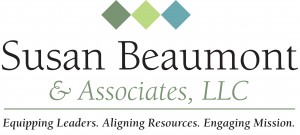by Susan Beaumont
Q: I’ve always heard that the governing board of a congregation should grow smaller as the church becomes larger. Why is that? Is there an ideal size?
A: Effective boards in every size congregation must tend to three types of work: fiduciary (tending to the stewardship of tangible assets), strategic (working to set the congregation’s priorities and seeing that resources are being deployed in accordance with those priorities) and generative (problem framing and sense making about the shifting environment of the congregation).1
In the large congregation, many of the fiduciary responsibilities of the board are better delegated to others. The board can never abdicate its responsibility for fiduciary oversight, but it can rely on board committees and the staff team to do much of the fiduciary work on its behalf. As congregations grow larger, governing boards must increasingly focus their time on the strategic and generative work of the congregation if the congregation is going to thrive. This type of work is best accomplished by smaller decision making bodies, with specific skill sets in strategic leadership.
The board of the multi-celled congregation (200-400 in weekend worship attendance)2 is often consumed by fiduciary work. The staff team is not yet large enough to assume the full managerial responsibilities of the church, and lay leadership is still actively involved in the management of ministry. Governing bodies in this size congregation are often representational in nature, consisting of the people who are doers and managers of the ministry alongside the staff team. Much of the monthly board meeting is wrapped up in planning for and reporting on ministry management. This board often needs to make special provisions for strategic planning work, outside of the context of their monthly meetings.
The governing board in the professional-sized congregation (400-800 in weekend worship attendance) is intuitively drawn toward a more balanced focus between fiduciary and strategic work. The largest struggle of the board is figuring out how to be more strategic and generative on a regular basis. The staff team is becoming highly specialized and is better able than the board to tend to operational management. The board must avoid micro-managing the staff. Congregations in this size category feel the need to reduce the size of the board in order to move away from reporting out/operational management and into more strategic and generative work.
Healthy congregations in the strategic-sized category (800-1,200 in weekend worship attendance) have generally learned some things about delegating the fiduciary work of the board, in service to more time spent on strategic and generative work. The governing body in this congregation has typically been downsized to create a more nimble decision making body. The voice of the staff team is represented by the senior clergy leader and the executive pastor. Other professional staff members attend board meetings only when invited, to evaluate or reflect upon a particular aspect of ministry that rests within the staff member’s sphere of influence.
What size is the right size? A group trying to engage in effective strategic decision making faces two key challenges. The first is the management of communication. The second is decision making accuracy. Generally having more people in a group will increase the likelihood that someone will have the information needed to make the decision and someone will propose a correct choice or solution. However, more people produce more opinions that have to be communicated and discussed. This makes the management of communication process more difficult, which ultimately ends up reducing decision making effectiveness.
The difficulty of managing communication within a small group is roughly proportional to the number of possible social interactions within the group. With two people there is only one possible social interaction. With three people there are three possible two-person interactions and one three way interaction for a total of four possible interactions. The number of possible social interactions begins to explode in groups with more than five people.
Most of us cannot imagine reducing our governing bodies down to 5 individuals, but the closer we can get to that number, the more effective our problem solving will be. Larger groups require skillful leadership and formal structures in order to function effectively. Formal structures, such as parliamentary procedures, work by deliberately stifling many of the possible social interactions. Unfortunately, this can also stifle creativity which is critical for strategic and generative work, and it also insures that most decision making will be dominated by the most politically influential individuals in the room, whether or not they have the best ideas.3
__________
Notes
1. Richard Chait, William Ryan, Barbara Taylor. Governance as Leadership: Reframing the Work of Nonprofit Boards. Hoboken, NJ: John Wiley and Sons. 2005. Pages 6-10.
2. The size categories referenced in this article originally appeared in the Summer 2008 issue of Congregations in an article entitled “Beyond Corporate: New Insights on Larger Churches.”
3. “How to Design Small Decision Making Groups,” found athttp://www.intuitor.com/statistics/SmallGroups.html on 08/03/2010.
Congregations, 2011-04-01
Volume 1 2011, Number 1
